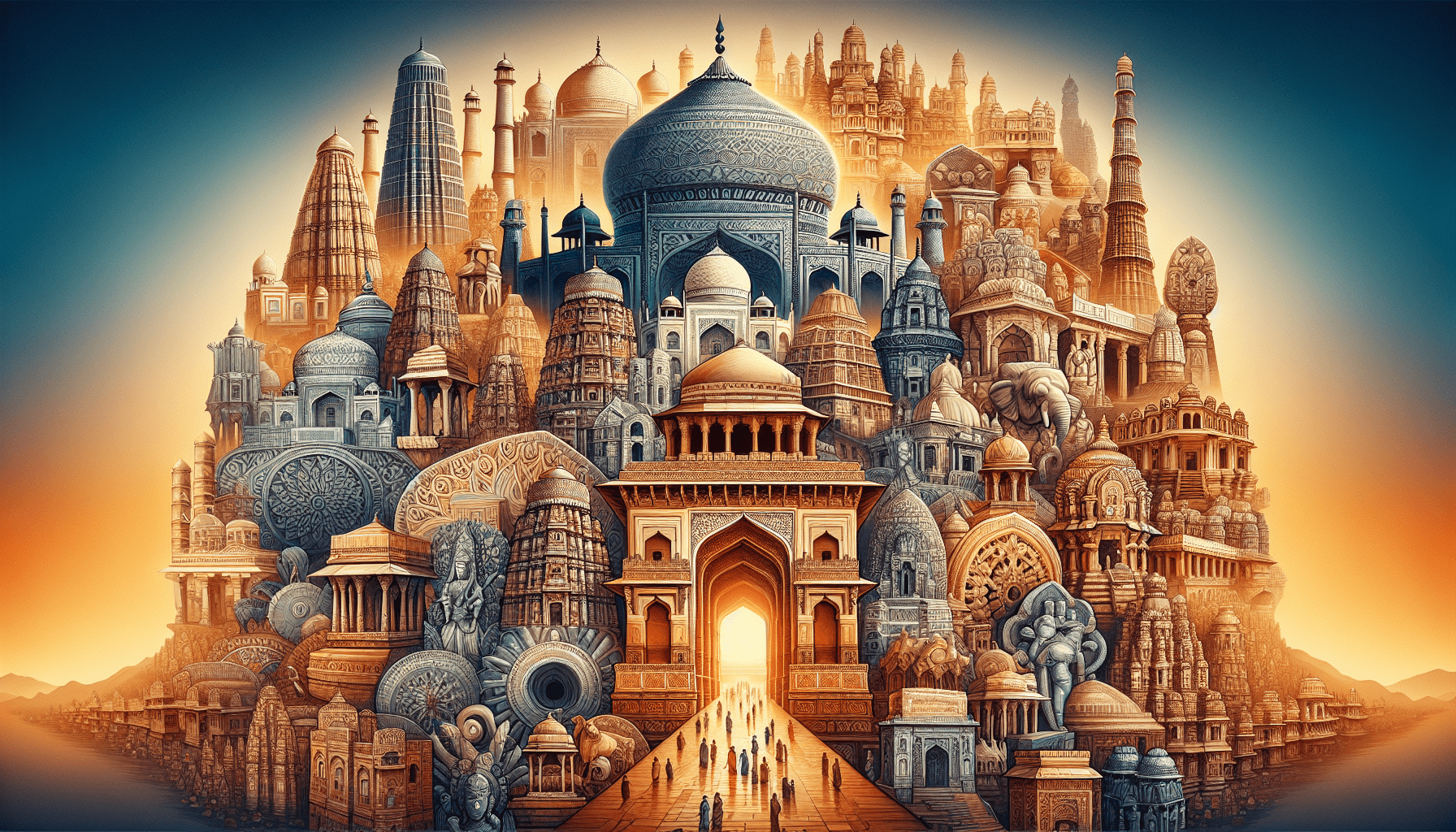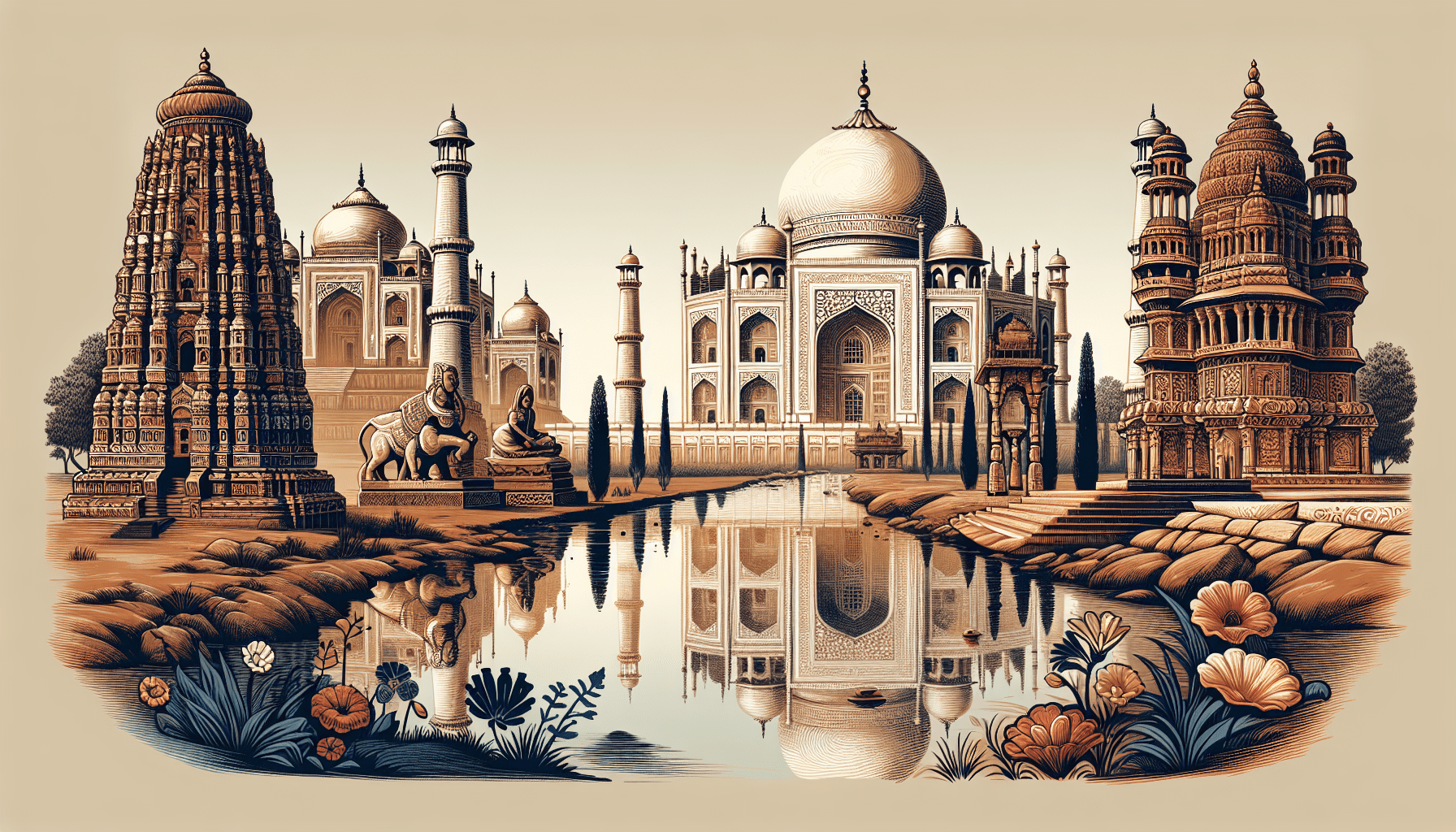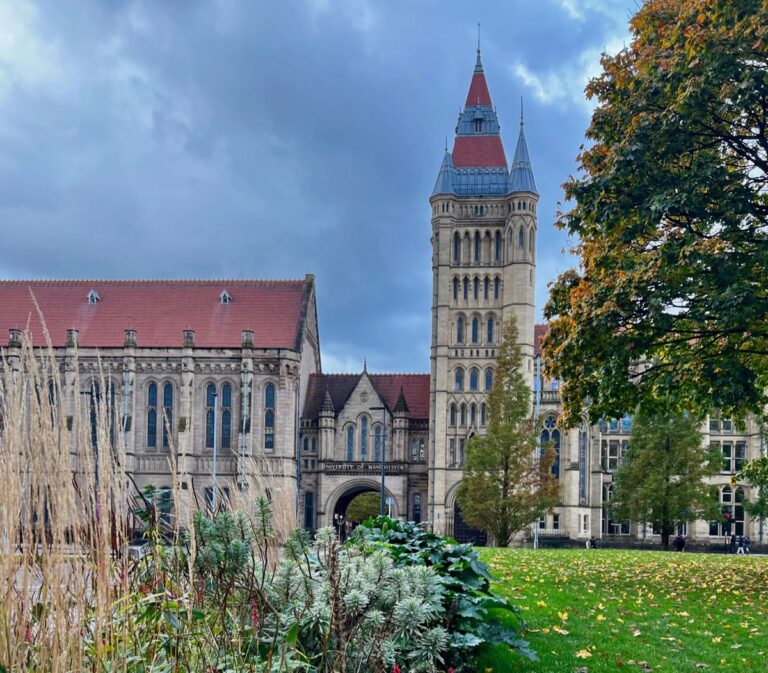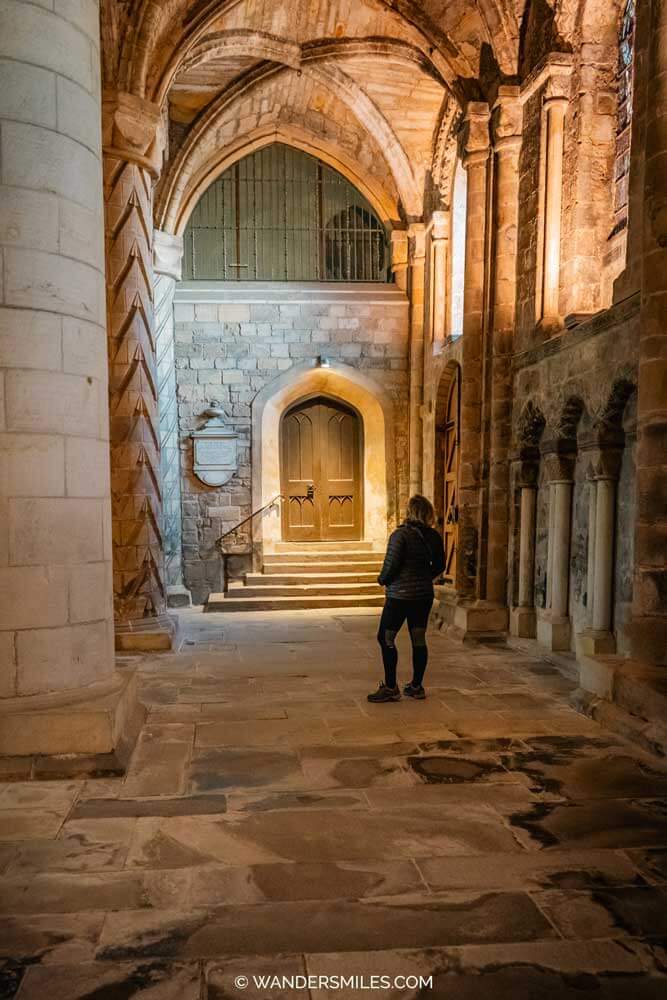DEPOZA 16 Pack Travel Bottles Set - TSA Approved Leak Proof Silicone Squeezable Containers for Toiletries, Conditioner, Shampoo, Lotion & Body Wash Accessories (16 pcs/Black Pack)
$9.99 (as of April 16, 2025 04:30 GMT +00:00 - More info)Looking to experience the mesmerizing monuments of India? Look no further! In this article, we will explore the must-see monuments in India that will leave you in awe. From the iconic Taj Mahal to the ancient ruins of Hampi, India is home to some of the most breathtaking architectural wonders in the world. Get ready to immerse yourself in the rich history and cultural heritage of this incredible country as we take you on a virtual journey through its most remarkable landmarks. So, pack your bags and get ready for an unforgettable adventure through India’s spectacular monuments.
As you embark on this virtual tour, you’ll discover the historical significance and architectural marvels of each monument. From the intricate detailing of the Mysore Palace to the grandeur of the Red Fort in Delhi, each monument has a unique story to tell. So, get ready to be amazed as we delve into the must-see monuments in India that will leave you in awe.

The Taj Mahal
Description of the Taj Mahal
The Taj Mahal, located in the city of Agra, India, is one of the most iconic and beautiful structures in the world. It is often referred to as the “symbol of love” due to its romantic history. Built in the 17th century by Mughal Emperor Shah Jahan as a mausoleum for his beloved wife Mumtaz Mahal, the Taj Mahal stands as a testament to their eternal love. The monument is made entirely of white marble and is known for its stunning architecture and intricate details. It is surrounded by beautiful gardens and reflects a sense of tranquility and serenity.
Architectural details
The Taj Mahal is a masterpiece of Mughal architecture, combining elements of Indian, Persian, and Islamic design. The main structure is a large white marble mausoleum, with four minarets at each corner. The central dome is the most prominent feature of the Taj Mahal, reaching a height of 240 feet. It is adorned with intricate carvings and inlaid with precious gemstones, adding to its grandeur.
The interiors of the Taj Mahal are equally impressive, with intricate floral and geometric designs carved into the marble walls. The tomb of Mumtaz Mahal is placed in the center of the mausoleum, while Shah Jahan’s tomb is beside it, symbolizing their eternal unity even after death. The use of symmetry throughout the structure creates a sense of balance and harmony.
Historical significance
The Taj Mahal holds immense historical significance as a symbol of love, as well as being recognized as a UNESCO World Heritage Site. It showcases the grandeur and artistic excellence of the Mughal Empire, which ruled over India during the 16th and 17th centuries. The construction of the Taj Mahal took over 20 years to complete and involved the work of thousands of skilled artisans and craftsmen.
The Taj Mahal also serves as a pilgrimage site for Muslims, as it houses the tombs of Mumtaz Mahal and Shah Jahan. It attracts millions of visitors from around the world who come to admire its beauty and pay tribute to the enduring love of Shah Jahan and Mumtaz Mahal.
The Red Fort
Description of the Red Fort
The Red Fort, also known as Lal Qila, is a historic fort located in the heart of Old Delhi, India. Built during the 17th century by Mughal Emperor Shah Jahan, it served as the main residence of the Mughal emperors until the capital shifted to Delhi. The Red Fort is a symbol of India’s rich history and architectural grandeur.
Architectural details
The Red Fort spans an area of over 250 acres and is surrounded by massive red sandstone walls, giving it its distinctive name. The fort complex consists of various palaces, museums, gardens, and iconic structures such as the Diwan-i-Aam (Hall of Public Audience) and the Diwan-i-Khas (Hall of Private Audience). The structures within the fort showcase a blend of Persian, European, and Indian architectural styles.
The fort’s intricate design includes intricate carvings, delicate marble work, and beautiful Islamic calligraphy. The use of red sandstone, combined with white marble, creates a visual contrast that enhances the fort’s beauty. The elaborate gardens within the fort, such as the Hayat Bakhsh Bagh, provide a serene and peaceful atmosphere.
Historical significance
The Red Fort holds great historical significance as it was the center of power for the Mughal Empire for several centuries. It witnessed the rise and fall of emperors, the grandeur of Mughal courts, and important historical events. The fort was the site of the first Indian rebellion against British colonial rule in 1857, marking a turning point in India’s struggle for independence.
Today, the Red Fort is a popular tourist destination that attracts visitors from around the world. It serves as a reminder of India’s rich cultural heritage and the architectural brilliance of the Mughal era.
Hampi
Description of Hampi
Hampi is an ancient city located in the southern state of Karnataka, India. It was once the capital of the Vijayanagara Empire, one of the greatest empires in Indian history. Hampi is known for its exceptional architecture, rich history, and stunning landscapes. The ruins of the ancient city stand as a testament to its former glory and attract tourists from far and wide.
Architectural details
The architecture of Hampi showcases a blend of Hindu and Islamic styles, reflecting the influence of the Vijayanagara Empire’s diverse cultural and artistic traditions. The city is filled with magnificent temples, intricate carvings, and grand structures that exemplify the architectural excellence of the era.
The Virupaksha Temple is one of the most famous landmarks in Hampi, dedicated to Lord Shiva. Its towering gopuram (entrance tower) and intricate sculptures are truly awe-inspiring. Another remarkable structure is the Lotus Mahal, an elegant pavilion with beautifully carved arches and domes. The Vittala Temple Complex is renowned for its musical pillars that produce different sounds when tapped.
Historical significance
Hampi was once a thriving cultural and commercial center, attracting traders from across the globe. The city flourished under the Vijayanagara Empire’s rule and was renowned for its wealth, art, and architecture. However, Hampi came under attack and was destroyed by invading armies in the 16th century, leading to the empire’s decline.
Today, Hampi is a UNESCO World Heritage Site and serves as a reminder of the imperial past of India. It is a living testament to the artistic, cultural, and architectural achievements of the Vijayanagara Empire.
Qutub Minar
Description of Qutub Minar
The Qutub Minar is a towering minaret located in Delhi, India. It is one of the most famous landmarks in the city and has become an iconic symbol of India’s rich cultural heritage. The minaret stands within the Qutub Complex, a UNESCO World Heritage Site, which includes several other historical structures.
Architectural details
The Qutub Minar is made of red sandstone and marble and reaches a height of 240 feet, making it the tallest brick minaret in the world. The structure consists of several storeys, each adorned with intricately carved balconies and inscriptions. The minaret is surrounded by lush green gardens, adding to its beauty and tranquility.
The architecture of the Qutub Minar reflects a fusion of Persian and Indian styles, showcasing the influence of the Delhi Sultanate era. The intricate detailing and decorative motifs highlight the craftsmanship and artistic skill of the time.
Historical significance
The construction of the Qutub Minar was started in the 12th century by Qutub-ud-din Aibak, the founder of the Delhi Sultanate. It was completed by his successor, Iltutmish. The minaret was built to commemorate the victory of the Sultanate over the last Hindu kingdom in Northern India.
Over the centuries, the Qutub Minar has witnessed several additions and modifications, including the construction of additional storeys and the addition of balconies. It stands as a testament to the rich history of Delhi and the architectural legacy of the Delhi Sultanate.
Visitors from around the world come to admire the Qutub Minar and explore the surrounding Qutub Complex. The site provides a glimpse into India’s medieval past and offers a serene and peaceful atmosphere for all to enjoy.

Ajanta and Ellora Caves
Description of Ajanta and Ellora Caves
The Ajanta and Ellora Caves are a collection of ancient rock-cut caves located in the Aurangabad district of Maharashtra, India. These caves are renowned for their stunning rock-cut architecture, intricate carvings, and exquisite artwork. They are recognized as UNESCO World Heritage Sites and attract tourists from all over the world.
Architectural details
The Ajanta Caves primarily consist of Buddhist caves, while the Ellora Caves showcase a mix of Buddhist, Hindu, and Jain caves. The caves were carved out of solid volcanic rock and feature elaborate sculptures, paintings, and monastic halls.
The Ajanta Caves are known for their stunning frescoes, depicting scenes from the life of Buddha and various Buddhist teachings. The Ellora Caves feature intricate sculptures of Hindu deities such as Shiva, Vishnu, and Durga, showcasing the religious diversity of ancient India.
The architecture of both sets of caves reflects the distinct artistic styles of different time periods. The Ajanta Caves date back to the 2nd century BCE and showcase early Buddhist rock-cut architecture. The Ellora Caves, on the other hand, were carved during the 5th to 10th centuries CE and display a more evolved and refined style.
Historical significance
The Ajanta and Ellora Caves provide valuable insights into the history, art, and culture of ancient India. They showcase the rich religious and artistic traditions that flourished during various periods of Indian history.
The Ajanta Caves were used for religious purposes by Buddhist monks, serving as meditation halls and monasteries. These caves remained hidden for centuries until their rediscovery in the 19th century.
The Ellora Caves, spanning over a period of 800 years, represent the evolution and fusion of different religious traditions in India. They were built and patronized by various dynasties, including the Chalukyas, Rashtrakutas, and Yadavas.
Today, the Ajanta and Ellora Caves are not only a testament to India’s ancient artistic heritage but also serve as important pilgrimage sites for Buddhist, Hindu, and Jain communities.
Khajuraho Temples
Description of Khajuraho Temples
The Khajuraho Temples are a group of ancient Hindu and Jain temples located in the town of Khajuraho, Madhya Pradesh, India. Built between the 10th and 12th centuries by the Chandela dynasty, these temples are renowned for their intricate carvings, depicting various aspects of human life, spirituality, and sexuality. The Khajuraho Temples have been designated as a UNESCO World Heritage Site.
Architectural details
The Khajuraho Temples showcase a unique blend of Nagara and Dravidian architectural styles. The temples are made of sandstone and feature tiered spires, intricately carved pillars, and sculptures.
The most striking feature of the Khajuraho Temples is the explicit depiction of human sexuality in the form of erotic sculptures. These sculptures, found on the outer walls of the temples, represent the celebration of love, passion, and the pursuit of spiritual enlightenment. They are a testament to the liberal and open-minded culture of the Chandela dynasty.
Aside from the erotic sculptures, the Khajuraho Temples also depict scenes from Hindu mythology, daily life, and spiritual practices. Each temple is dedicated to a specific deity and showcases unique architectural and sculptural elements.
Historical significance
The Khajuraho Temples reflect the religious and cultural life of the Chandela dynasty, who ruled over this region of central India. These temples were built as places of worship and served as a center for spiritual and cultural activities.
Over time, the Khajuraho Temples fell into obscurity and were largely forgotten. They were rediscovered in the 19th century and have since gained international recognition for their architectural beauty and erotic sculptures.
The Khajuraho Temples are not only a testament to the artistic and architectural excellence of the Chandela dynasty but also serve as a representation of the diverse religious and cultural traditions that thrived in ancient India.
Mysore Palace
Description of Mysore Palace
Mysore Palace, also known as the Amba Vilas Palace, is a magnificent royal residence located in the city of Mysore, Karnataka, India. It is the official residence of the Wadiyar dynasty, the former rulers of the Kingdom of Mysore. Mysore Palace is renowned for its grand architecture, intricate artwork, and opulent interiors.
Architectural details
The Mysore Palace showcases a blend of architectural styles, including Indo-Saracenic, Rajput, and Mughal influences. The palace is built in the Indo-Saracenic style, which combines elements of Hindu, Islamic, and European architecture.
The palace is a visual marvel, with its intricately carved arches, domes, and towers. The main entrance, known as the Gombe Thotti or Doll’s Pavilion, is adorned with beautiful frescoes and houses a collection of traditional Indian dolls.
The interiors of the palace are equally awe-inspiring, with lavish halls, stained glass windows, and intricate mosaic floors. The Durbar Hall, with its ornate ceiling and chandeliers, served as the venue for royal ceremonies and public gatherings.
Historical significance
Mysore Palace has historical and cultural importance as the seat of the Wadiyar dynasty, who ruled over the Kingdom of Mysore for several centuries. It represents the grandeur and opulence of the royal era and serves as a symbol of Karnataka’s rich heritage.
The original wooden palace was destroyed by fire in the late 19th century and was rebuilt in its current form. The palace has witnessed the grandeur of royal celebrations and important historical events.
Today, Mysore Palace attracts millions of visitors who come to marvel at its architectural beauty and explore its rich history. The palace is particularly famous during the Dussehra festival, when it is lit up with thousands of lights and becomes a spectacular sight to behold.
Amber Fort
Description of Amber Fort
The Amber Fort, also known as Amer Fort, is a magnificent fort located on a hilltop in Amer, near Jaipur, Rajasthan, India. Built in the 16th century by Raja Man Singh I, it served as the main residence of the Rajput kings of Jaipur. The Amber Fort is renowned for its stunning architecture, elaborate frescoes, and breathtaking views of the surrounding landscape.
Architectural details
The Amber Fort showcases a unique blend of Hindu and Islamic architectural styles, reflecting the cultural and artistic influences of the time. The fort is made of yellow and pink sandstone, giving it a warm and vibrant appearance.
The fort complex consists of several palaces, courtyards, and gardens. The Diwan-i-Aam (Hall of Public Audience) and the Diwan-i-Khas (Hall of Private Audience) are notable structures within the fort. The Sheesh Mahal (Mirror Palace) is renowned for its intricate mirror work, reflecting light and creating a mesmerizing effect.
One of the highlights of visiting the Amber Fort is the opportunity to ride on an elephant to reach the entrance. This traditional mode of transportation adds to the royal and enchanting experience.
Historical significance
The Amber Fort holds great historical significance as it was the seat of power for the Rajput kings of Jaipur. It witnessed the glory and splendor of the Rajput era and served as a symbol of their valor and grandeur.
The fort also played a significant role in various historical events, including battles and alliances. It was attacked and occupied by various rulers, including the Mughals, before finally coming under the control of the Kachwaha rulers of Jaipur.
Today, the Amber Fort stands as a popular tourist attraction and offers visitors a glimpse into the rich history and architectural brilliance of Rajasthan. The fort’s grandeur, panoramic views, and intricate craftsmanship make it a must-visit destination for travelers.
Konark Sun Temple
Description of Konark Sun Temple
The Konark Sun Temple is a UNESCO World Heritage Site located in Konark, Odisha, India. It is one of the most famous temples in India and is dedicated to the sun god, Surya. The temple is renowned for its architectural grandeur, intricate stone carvings, and its shape resembling a colossal chariot.
Architectural details
The Konark Sun Temple is designed in the shape of a massive chariot, with 24 intricately carved stone wheels and horses. The temple is made of black granite and stands as a testament to the architectural genius of the Ganga dynasty.
The main temple originally had a towering shikara (tower), but it collapsed centuries ago. However, the remnants of its base can still be seen. The temple’s walls are adorned with exquisite carvings, depicting scenes from Hindu mythology, celestial beings, and intricate designs.
One of the most remarkable features of the Konark Sun Temple is the Natya Mandir, or the Dance Hall. This intricately carved structure was used for performances and rituals. The Sun Temple complex also includes smaller shrines, reservoirs, and a museum showcasing artifacts related to the temple’s history.
Historical significance
The Konark Sun Temple was built in the 13th century by King Narasimhadeva I of the Ganga dynasty. It was a center of worship and an important pilgrimage site for devotees of the sun god.
Over the centuries, the temple fell into disrepair and was partially covered by sand. It was rediscovered and excavated in the 19th century, leading to its restoration and recognition as a national treasure.
The Konark Sun Temple represents the architectural brilliance of ancient India and the devotion of its people. It continues to inspire awe and admiration among visitors, who come to admire its intricate carvings and experience its spiritual energy.
Conclusion
India is a land of incredible architecture and historical marvels. Each of the mentioned landmarks – the Taj Mahal, Red Fort, Hampi, Qutub Minar, Ajanta and Ellora Caves, Khajuraho Temples, Mysore Palace, Amber Fort, and Konark Sun Temple – has its own unique charm and significance.
These landmarks showcase the diverse cultural heritage, artistic brilliance, and historical richness of India. Whether it’s the eternal symbol of love at the Taj Mahal, the grandeur of royal palaces, or the intricate carvings of ancient temples, each site offers a glimpse into India’s glorious past and its enduring cultural legacy.
Visiting these landmarks allows you to not only witness their architectural splendor but also immerse yourself in India’s vibrant history and traditions. From the Mughal and Rajput era to the ancient kingdoms of South India, each site has its own story to tell.
Exploring these landmarks is like embarking on a journey through time, where you can witness the architectural excellence of bygone eras and learn about the empires, rulers, and religious practices that shaped India’s history.
Whether you’re a history enthusiast, an architecture lover, or simply someone who enjoys immersing themselves in the beauty of cultural heritage, these landmarks in India offer an unforgettable experience that will leave an indelible mark on your soul.






